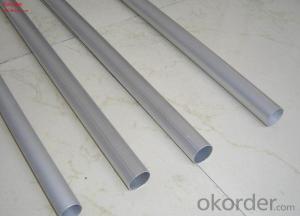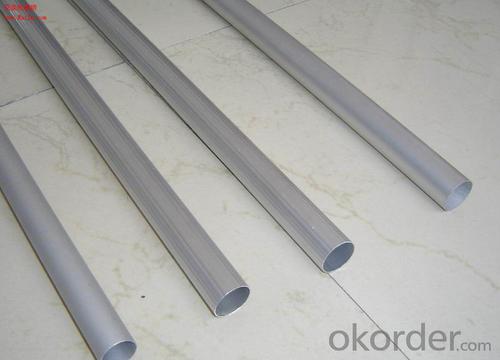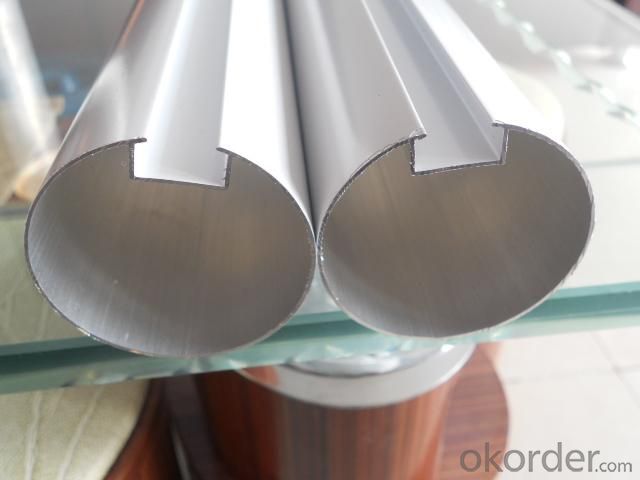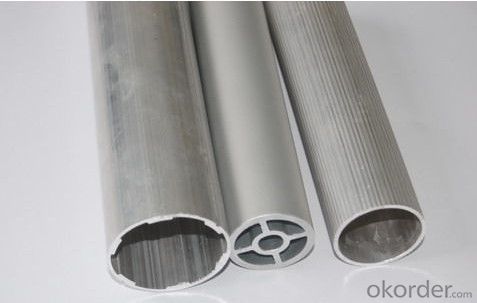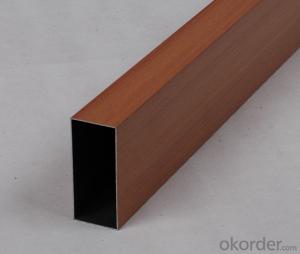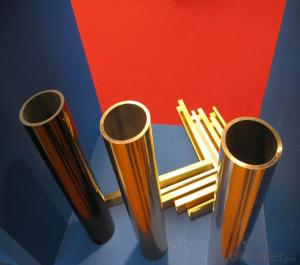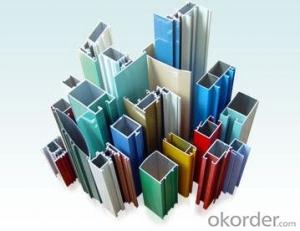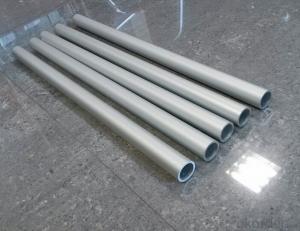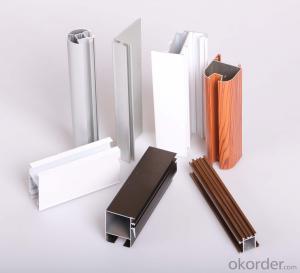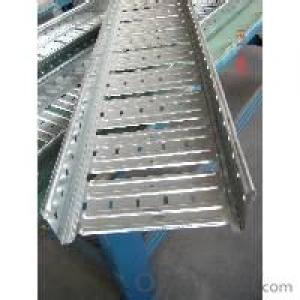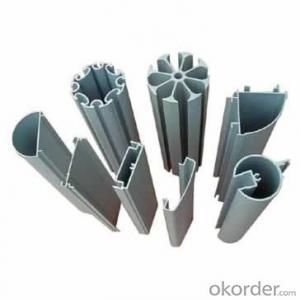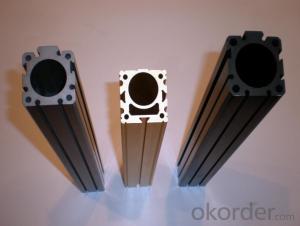T-Slot Aluminum Profiles for Anodized Aluminum Tubes Used on Furniture
- Loading Port:
- Shanghai
- Payment Terms:
- TT OR LC
- Min Order Qty:
- 5 m.t.
- Supply Capability:
- 500 m.t./month
OKorder Service Pledge
OKorder Financial Service
You Might Also Like
Specifications
Specifications
1.Type:Anodized aluminium tube
2.Thickness: 0.7mm
3.Temper:T3-T8
Specifications of Anodized Aluminum Tube:
1. Grade : 6063, 6061, 6060, 6005, 6005A, etc
2. Temper :T4, T5 or T6
3. Various colors :sliver, bronze, black, gold, blue, gray, champagne, bright, etc
4. Machining :cutting, punching, drilling, tapping, milling, bending
5. Wall thickness : 0.2mm-150mm or custom
6. Surface Treatment : Anodized,brushed,mill finished,polished, powder coated, sand blast, etc
7. Length :1m-12m
8. Outer Diameter : 4mm-2500mm
Applications of Anodized Aluminum Tube:
1.Agricultural
2.Electronics
3.Tower buildings
4.Material
5.Aviation fixtures
6.Automobile
7.Mechanical
8.Trucks
9.Ships
10.Aluminum window
11.Door
12.Curtain wall
Package of Anodized Aluminum Tube:
SMC Products are packed and labeled according to the regulations and customer's requests. Great care is taken to avoid any damage which might be caused during storage or transportation. In addition, clear labels are tagged on the outside of the packages for easy identification of the product I. D. and quality information.
1)SMC Standard
2)Customization
- Q: This question asks if aluminum profiles can be utilized in cold weather conditions and seeks an explanation for their suitability.
- <p>Yes, aluminum profiles can be used in cold climates. Aluminum is a lightweight and durable material that maintains its strength and structural integrity even in extreme low temperatures. It does not rust or corrode, which makes it ideal for use in environments with harsh weather conditions. Additionally, aluminum has good thermal conductivity, which allows it to dissipate heat effectively, but it also has low thermal expansion, meaning it does not expand or contract significantly with temperature changes. This characteristic helps prevent warping or cracking in cold climates. Properly designed and installed aluminum profiles can withstand the challenges of cold weather without compromising their performance or longevity.</p>
- Q: What are the noise reduction properties of aluminum profiles?
- Aluminum profiles have good noise reduction properties due to their ability to absorb and dampen sound vibrations. The high density and stiffness of aluminum help to minimize noise transmission, making it an effective material for reducing unwanted noise in various applications.
- Q: This question asks for the correct procedure to install aluminum profiles.
- <p>To install aluminum profiles correctly, follow these steps: 1. Measure and mark the positions where the profiles will be installed. 2. Clean the surfaces to ensure proper adhesion. 3. Use a suitable adhesive or mechanical fasteners recommended for aluminum. 4. Align the profile with the marked positions and secure it in place. 5. Check for level and plumb, and adjust as needed. 6. Wipe away any excess adhesive and clean the profile. 7. Allow the adhesive to cure according to the manufacturer's instructions. 8. Inspect the installation for any gaps or misalignments and make corrections if necessary. Always refer to the specific installation guidelines provided by the aluminum profile manufacturer for best results.</p>
- Q: Can aluminum profiles be used in elevator or escalator systems?
- Indeed, elevator or escalator systems can incorporate aluminum profiles. These profiles possess qualities such as being lightweight, durable, and resistant to corrosion, rendering them appropriate for a range of uses, including the construction of elevator and escalator elements. Aluminum profiles can serve as the structural framework, handrails, cladding, and other components within an elevator or escalator system. Furthermore, these profiles can be effortlessly tailored and manufactured to fulfill the exact specifications of each project. The adaptability, ratio of strength to weight, and visual attractiveness of aluminum profiles establish them as a superb option for elevator and escalator systems.
- Q: Including the element parameters, the price and the difference between 6063, what is the use and so on!How about 6060 100/ meters? How much is the strength? How much is the price more than 6063?
- Physical and mechanical properties:The ultimate tensile strength of B (MPa): more than 205 conditions yield strength of 0.2 (MPa): more than 170 elongation 5 (%): 96063 aluminum plate product features introduction:6063, it belongs to Al-Mg-Si alloy. It has a wide range of applications, especially in the construction industry. The alloy is the most promising alloy. It has good corrosion resistance, good weldability, cold workability and medium strengthThe main alloying elements as magnesium and silicon, has excellent processing properties, excellent weldability, extrusion and electroplating, good corrosion resistance, toughness, easy polishing, color film, the effect of anodic oxidation is excellent, is typical of the extruded alloy.6063 Aluminum Alloy profile with its good plasticity and moderate heat treatment strength, good welding performance and anodized surface gorgeous color is widely used in building materials, irrigation pipe, for the vehicle, bench, furniture, fences and other lifts, with tubes, rods and profiles.Low alloyed Al-Mg-Si high plasticity alloy.
- Q: Are aluminum profiles suitable for use in architectural lighting fixtures?
- <p>Yes, aluminum profiles are commonly used for architectural lighting fixtures due to their durability, lightweight nature, and excellent heat dissipation properties. They offer design flexibility and can be easily shaped and machined to fit various lighting designs. Additionally, aluminum's resistance to corrosion makes it ideal for both indoor and outdoor lighting applications.</p>
- Q: How do aluminum profiles perform in terms of vibration resistance?
- Aluminum profiles are known to have excellent vibration resistance properties. The inherent characteristics of aluminum, such as its lightweight nature and high strength-to-weight ratio, contribute to its ability to dampen vibrations effectively. Aluminum profiles can absorb and dissipate energy generated by vibrations, reducing the risk of structural damage and ensuring the integrity of the overall system. Furthermore, aluminum profiles can be designed with various geometries and cross-sectional shapes, allowing for enhanced stiffness and rigidity. This improved structural stability helps in minimizing the transmission of vibrations throughout the profile, resulting in reduced resonance and vibration amplification. In addition to these inherent properties, aluminum profiles can be further enhanced through various methods, such as extrusion processes and surface treatments. Extrusion processes can shape the aluminum profiles to specific configurations, optimizing their vibration resistance capabilities. Surface treatments, such as anodizing or powder coating, can provide an additional layer of protection against corrosion and wear, further enhancing the longevity and performance of the profiles. Overall, aluminum profiles excel in terms of vibration resistance due to their lightweight nature, high strength-to-weight ratio, and the ability to be customized for specific applications. These qualities make them an ideal choice for a wide range of industries, including automotive, aerospace, and construction, where vibration control is crucial for maintaining product performance and safety.
- Q: Excuse me, aluminum oxidation and electrophoresis have what different?
- Alumina:The substrate is used as an anode to be electrolyzed in an electrolyte, and a protective oxide film is formed on the surface of the substrate artificially so as to form an oxidized aluminum materialMain features of aluminium oxide material:1. It has strong wear resistance, weather resistance and corrosion resistance2, you can form a variety of colors on the substrate surface, the maximum to suit your requirements3, hardness is strong, suitable for all kinds of building, industrial material production
- Q: Can aluminum profiles be used in roofing systems?
- Indeed, roofing systems can utilize aluminum profiles. Aluminum, being a lightweight and durable substance, showcases resistance to corrosion, rendering it an excellent selection for roofing purposes. Aluminum profiles can be employed in the construction of diverse roofing elements, including gutters, downspouts, and flashing, which effectively redirect water away from the roof, inhibiting leaks. Furthermore, aluminum profiles can be conveniently crafted and tailored to fit the particular needs of a roofing system. Altogether, aluminum profiles present numerous benefits for roofing systems, encompassing strength, durability, and resilience against weathering, thereby establishing them as a favored option for both residential and commercial roofing ventures.
- Q: Are aluminum profiles suitable for use in exterior wall systems?
- <p>Yes, aluminum profiles are commonly used for exterior wall systems due to their durability, low maintenance, and resistance to corrosion and weathering. They offer a lightweight and strong alternative to traditional materials, and can be designed to provide thermal insulation and aesthetic appeal. Their versatility allows for various configurations and customizations, making them suitable for a wide range of architectural styles and requirements.</p>
Send your message to us
T-Slot Aluminum Profiles for Anodized Aluminum Tubes Used on Furniture
- Loading Port:
- Shanghai
- Payment Terms:
- TT OR LC
- Min Order Qty:
- 5 m.t.
- Supply Capability:
- 500 m.t./month
OKorder Service Pledge
OKorder Financial Service
Similar products
Hot products
Hot Searches
Related keywords
